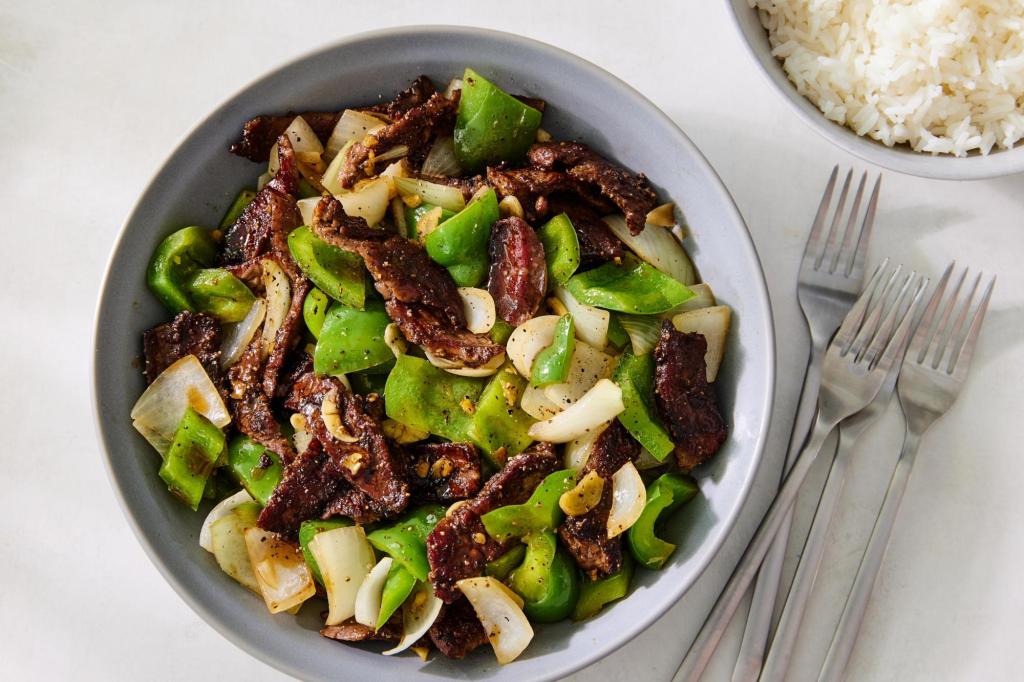By Eric Kim, The New York Times
“The only pepper I cannot abide is a green pepper,” cookbook author Nigella Lawson once wrote, aptly calling out the fruit’s bitter, undeveloped flavor.
“In an emergency,” she recently told me, “I can eat grilled or pan-cooked green bell peppers, as the heat and char give them a more balanced flavor, but they do really still taste underripe to me.”
It’s understandable. Next to its older siblings in blazing red, orange and yellow, the green bell pepper has never had the best reputation.
But, if you’re trying to capture the edge of bitterness, where savory and sweet intermingle, then the green pepper might be your ideal implement. That in-between flavor can be used to your advantage, whether infusing a gin cocktail with a vegetal aroma or lending clarity and balance in flavor bases, like sofrito, epis and the “holy trinity” of onion, pepper and celery in Cajun and Louisiana Creole cooking.
Perhaps the one dish where the diner must confront the unripe pepper head-on is pepper steak. For many Americans, what comes to mind is the saucy beef stir-fry seen on takeout menus and strewed with crunchy panels of Christmassy red and green bell peppers.
But in the Chinese culinary canon, peppery beef dishes take at least a couple of other forms. There’s a Cantonese-style banquet staple of beef punctuated with black pepper or a homey stir-fry of thin matchsticks of beef, with long hot peppers (which, contrary to their name, actually have a gentle, moderate heat). Sometimes called “shredded beef” on menus, it’s a dish that Sarah Leung, one-fourth of the power family behind the Woks of Life blog and cookbook, has seen linked to Sichuan and Fujian cuisines.
The Chinese American pepper steak, she said, “feels like a culmination of all of those influences.” The Leungs — Sarah, Kaitlin, Bill and Judy — published their first proper pepper steak recipe only recently, in April, using oyster sauce, chicken stock and red bell peppers in addition to the green.
What all these beef and pepper dishes have in common, ultimately, is their reliance on just a handful of impactful ingredients to flavor the meat, including the bell pepper, which lends its grassy (in a good way) fragrance to the sauce. In this interpretation, thin slices of flank or skirt steak, marinated in a simple, pared-down mix of soy sauce, honey and black pepper, cook up gloriously soft, caramelized and burnished.
The stir-frying is easy: A couple of minutes on high heat is all you need to sear the steak, along with enough fire under the wok or skillet to blister onions and the peppers’ delicate skins. (Look for “little brown dots,” Sarah Leung said.)
Handled like this, just charred but still crunchy within, a green bell pepper can positively gleam.
Recipe: Pepper Steak
The Chinese American stir-fry dish, pepper steak, celebrates the oft-maligned green bell pepper in all its savory, vegetal glory. In this version, thin slices of flank or skirt steak, marinated in a flavorful mix of soy sauce, honey and black pepper cook up beautifully tender yet burnished and caramelized at the edges. Be sure to chop all of your vegetables before you start cooking, since time at the stove is hot and fast with this easy recipe. — Eric Kim
Yield: 4 servings
Total time: 40 minutes, plus marinating time
Ingredients
- 1 pound beef flank or skirt steak (see Tip)
- 1 tablespoon cornstarch
- 2 1/2 teaspoons freshly ground black pepper, plus more for serving
- 3 1/2 tablespoons soy sauce, plus more to taste
- 2 tablespoons neutral oil, plus more for stir-frying
- 2 medium fresh green bell peppers or Cubanelle peppers, cut into 1-inch pieces
- 1 medium yellow onion, cut into 1-inch pieces
- 3 garlic cloves, crushed and thinly sliced
- 1 (1 1/2-inch) piece ginger, peeled, crushed and thinly sliced
- Salt
- 1/4 cup Shaoxing wine or dry sherry
- 2 tablespoons honey
- Cooked white rice, for serving
Preparation
1. Marinate the beef: Cut the steak into 2- or 3-inch-wide pieces along the grain, then cut into thin slices against the grain. In a bowl, combine the steak, cornstarch, black pepper, 2 1/2 tablespoons soy sauce and 2 tablespoons oil. Toss to mix, cover and marinate at room temperature for up to 30 minutes (see Tip), or in the refrigerator for up to 12 hours.
2. Stir-fry the beef: Heat a large wok or skillet over medium-high until a splash of water dropped into the pan evaporates quickly. Add enough oil to generously coat the pan, then add the beef in a single layer. Cook without flipping until the meat is browned around the edges, 2 1/2 to 3 minutes, then stir constantly until browned all over, about 30 more seconds. Transfer to a plate.
3. Add the peppers, onion, garlic and ginger to the same wok, still over medium-high heat. Season with salt and pepper. Cook, stirring occasionally, until the vegetables start to soften, 1 to 1 1/2 minutes.
4. Add the meat back to the pan, along with the Shaoxing wine, honey and the remaining 1 tablespoon soy sauce. Cook, stirring constantly and scraping up any stuck-on bits, until the liquid reduces greatly and slicks the vegetables and beef, 30 seconds to 1 minute. Taste and adjust seasoning with salt, pepper or soy sauce as desired. Serve immediately with rice.
Tips: If using a tougher cut like bottom round steak, add 1/4 teaspoon baking soda to tenderize the meat, but don’t let it marinate for longer than 30 minutes or it’ll turn mushy.
This article originally appeared in The New York Times.
Subscribe to our weekly newsletter, In The Know, to get entertainment news sent straight to your inbox.
Source: Read Full Article





